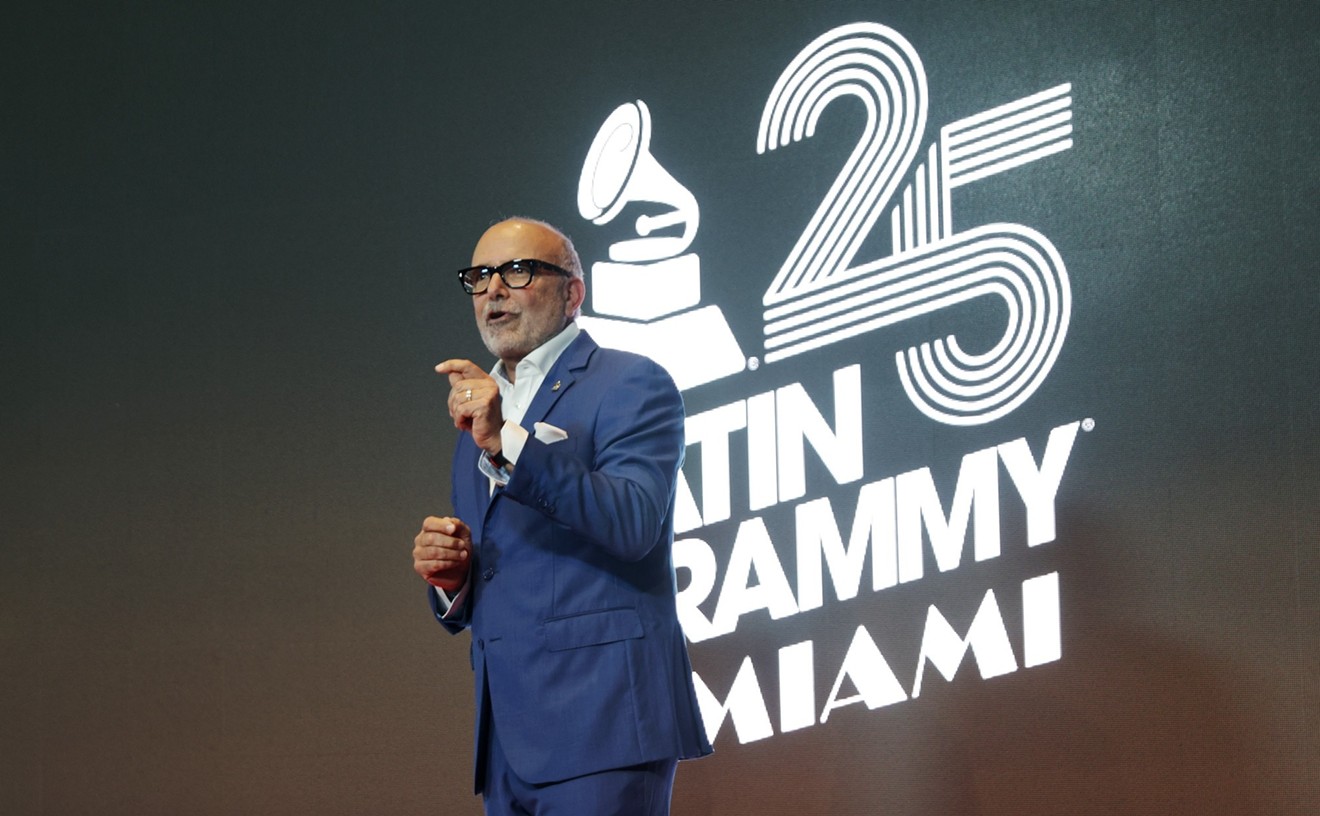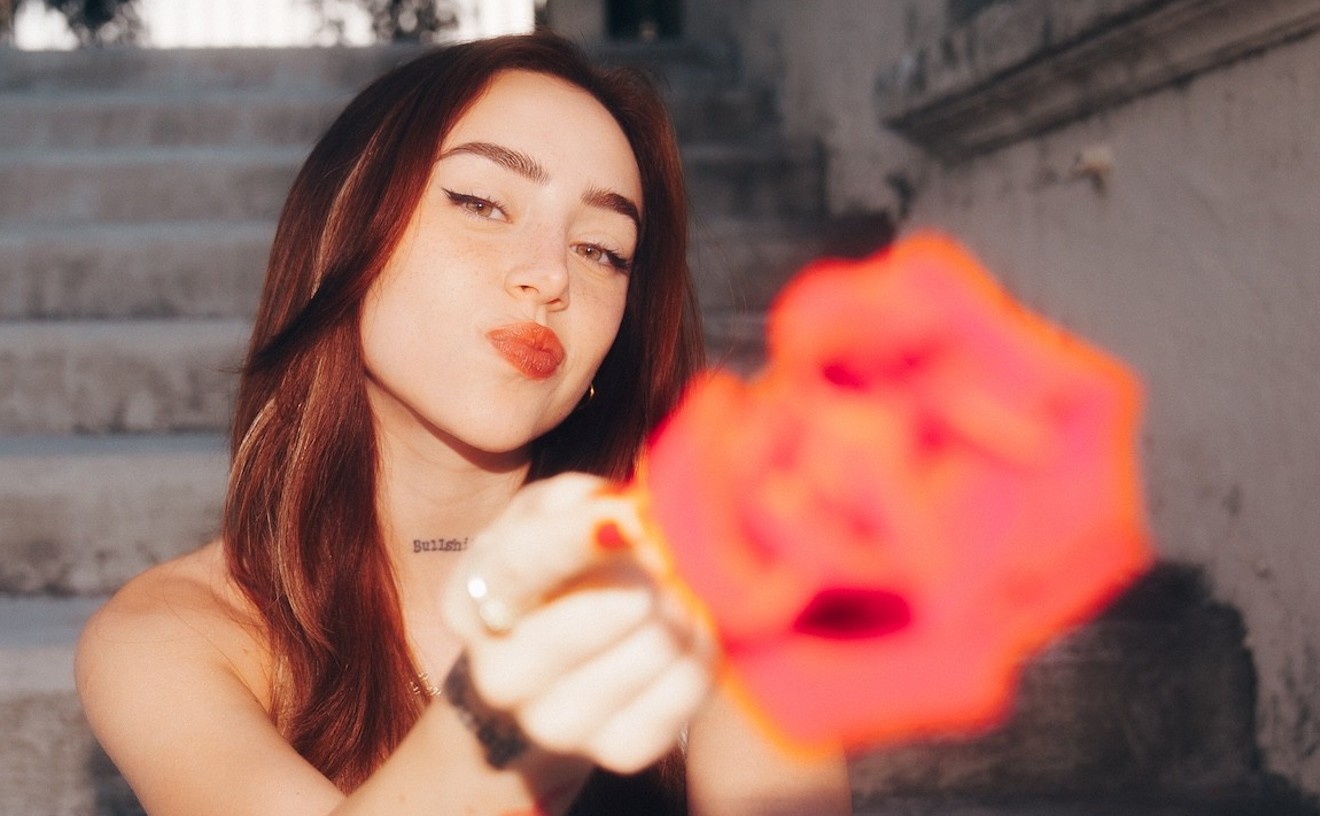Glimpses of the South Florida Scene is a weekly column devoted to the artists thriving within Broward and Palm Beach counties featuring interviews with the folks making it happen. This week, Astrea Corporation.
It's been established that Astrea Corporation make music for and from the future: somewhere between trip-hop and dubstep and soul. All the corniness of any "neo" version of these genres is removed and distilled into rapturous, MPC-driven landscapes created by Michael Bachman. What might not be as clear: these members of the local collective Black Locust Society really do want the reverberating soul of their tracks to penetrate and inspire everyone listening.
Third String Asimov, their first release, even has literally interactive components so listeners can reinterpret the songs themselves -- but more about that later. Carly Garrett, whose visual art and emotional, warmth-heavy vocals take Astrea Corporation from the stratosphere to the astral plane -- and is among the many performers filling out the Swarm 666 lineup this Saturday -- was kind enough to answer some questions about the group's inner workings.
New Times: Tell me about Astrea Corporation's beginnings. When did you guys get together and decide to do this? What were you working on before?
Carly Garrett: The beginnings of Astrea Corp was actually very organic. Mike [Bachman] had K-the-i??? (mc/producer from L.A.) coming into town for a show and had planned to play all the beats out live with a band. He approached Frank (formerly of A Jealousy Issue) and Sandor [Davidson] (formerly of Ketchy Shuby) and they immediately were down. As the set progressed, so did the element of experimentation, as did the improvised element. The result of this gave birth to the Astrea Corporation. My involvement in the group did not come till about two years after this.
Mike and I had been seeing each other for awhile, and although family and friends had mentioned to him that I sang, it was never a pressing topic in our relationship. I was waiting for him to get home from work one day, and decided to go listen to some tracks in the lab. As I was listening I felt compelled to start harmonizing with the sounds, and whatever rolled into my head began rolling off my tongue. Little to my knowledge, Mike had walked in and was quietly watching me the whole time! Shortly after this, I began laying down vocals for tracks and performing with the group, which ultimately led to me becoming a member of Astrea Corp.
There seems to be a strong connection between the band's visual art and music -- you have a really otherworldly aesthetic, and I'm digging the collages you offered to fans. Who makes the art, and how does it inform your music, if it does at all?
Mike and I have a huge appreciation for art, and feel the visual aesthetic of the Astrea Corporation is a key element to who we are and what we create. I make the collages based on elements that speak to me through what I'm currently vibing to. The collages offered to fans were specifically crafted to enhance intrigue and thoughtfulness for the Third String Asimov EP. I wanted the fans to feel appreciated, as we do, for their
support. So I sought to make a clear visual connection to our music, very space-y with eerie hints of beautiful oddities.
Tell me a little bit about Third String Asimov. I know it's part of a larger project, so give me the details! I'm also curious about how long the songs were in the making before they made it to the EP.
Third String Asimov is a three-part project we developed over the span of a year or so. We would set up our equipment and record improv jams. Just noodling around. Mike and Sandor would chop up random samples in their spare time and have them ready to drop. After these sessions, we would go back and listen to these recordings. Finding the best elements and segments, these would create the structure of songs we would flesh out later. For this particular project, we recorded all the songs directly to tape (on some shitty 1/4" reel to reel), then bounced them back to a computer.
Third String Asimov is actually our first series of works together as a unit, so it's something special to us. The concept is to release each segment bi monthly in various forms of physical packaging and try to get the listener involved as much as possible in the project. To do this, each release will include all the session files and stems to the songs, and a demo version of Ableton Live. We're allowing the listeners to instantly remix/reshape/deconstruct the songs in any way they like or dislike.
I really like the idea of a listener being involved. Will there be an opportunity for the listeners to share their own versions of the songs, like a site that enables them to upload them? Or is it intended to be a strictly personal project for the listeners?
The idea of giving the stems to the listener is by all means intended to be a shared experience. We intend to have an area on our website ready for the end of the year, where people can upload remixes/re-edits and have the ability to stream them online. We also had the idea of taking our favorite remixes and compiling them as a project at some point. There is a huge community of electronic/beat artists locally. We feel, what better way to build our local scene than to involve as many of them as possible. At the same time, being able to manipulate the tracks gives the individual the ability to experience the music the way they choose to. Almost like those old "choose your destiny books" we read as kids.
Besides singing, what else do you contribute in terms of songwriting? Is it primarily you and Mike writing lyrics? And when it comes to the music-making itself, does most of it evolve out of "jam sessions"?
Our recording process is pretty relaxed and stress free. Mike is constantly working, experimenting and fleshing out basic skeletons. Just noodling around until something clicks. We'll sit down and listen to all these demos and I basically have free range to do with it what I please. In return, I'll add some noise/synth elements if need be. A lot of times, I'll jump in when Mike's recording and start adding things on top. When it comes to writing, I'm solely responsible for the lyrics heard thus far. I may listen to a track a hundred times before any words even form though. I personally try not to rush the writing process, as I strongly believe creativity should flow naturally. I like to allow the song itself to speak to me. Many times I'll begin with melodies and harmonies, and then start to write the lyrics. Other times I may hear a track and automatically will be inspired to write something. If the lyrics work, we'll lay vocals down and record.
Can you tell me more about allowing the song to speak to you? I also think it's great that the lyrics are written by the girl in the group; there's not a lot of local female-led bands, and you're adding a really powerful element by writing.
I suppose it all depends on the song itself. Many of the songs I write are derived from things of personal importance and relevance, while others have been drawn from personal experiences. For example, one of the first songs I wrote for the Astrea Corporation, "Sometimes," was inspired by the death of my grandmother. She was diagnosed with cancer and her last few months, up to the day she passed away, were spent in our home. To watch a person literally deteriorate in front of your eyes had a profound impact on me. When I heard "Sometimes," the track had a very haunting feeling, and offered an outlet to express all these weird, uncomfortable feelings I was having. Due to the track itself, the words such as "Eerie visions, in my head...the air is stale where death has come to prevail" pretty much rolled off my tongue. Whereas some of the newer songs on Third String Asimov have been inspired from personal views on life,society and the world at this point in my life.
It's a beautiful thing that you were able to sort of encapsulate those feelings in a song without even trying to. You're a songwriter and visual artist -- does this expand to other outlets? You're a teacher, and creativity in the classroom is pretty important. Not to discuss too much of your personal life, but is there any overlap between your day-to-day life and your personal creativity?
Haha, I actually try my hardest not to have my day-to-day life overlap into my art. I feel that they are on such opposite ends of the spectrum, and I'd prefer to keep it that way. When I leave each day, I try to leave everything job-related in the classroom. I do agree that creativity is a very important part of teaching, but my creative mindset when working with children differs widely from what I create personally. I enjoy having the freedom to expand my vision through the art I create in ways that many times defies this reality; almost in an intangible way to a certain degree, as well as, evoke emotional keys between the song and the listener.
I read the review of your show at Green Room, and it was awesome. '90s-era trip-hop is one genre I think of when I hear you guys. Is this an era and genre you're familiar with? What other sorts of music are you into?
It's funny. After our first couple of shows, I was getting a lot of compliments on my voice and how it reminded people of Beth Gibbons (of Portishead). I literally had to ask Mike who that was. Hahaha. The whole Bristol trip-hop scene is something really close to Mike. Tricky was a major influence. But it was never an intentional thing to bring that influence to the forefront. My musical taste varies, like many things at different periods in my life. At the moment I've been listening to a lot of experimental and instrumental stuff. I have been incredibly inspired by artist such as Gang Gang Dance, Anti-Pop Consortium, Saturn Never Sleeps and Shabazz Palaces. I definitely have them on heavy rotation. I'm also currently listening to a lot of Flying Lotus, White Rainbow, Thundercat, M83 and Prefuse 73, but honestly it really depends on my mood.
Can you tell me anything about the Black Locust Society?
The Black Locust Society is a collective of artists and musicians, a network of some of the most talented folks in South Florida. The collective as a whole throws an occasional party (SWARM) at our secret hideout which includes everything--live bands, an art gallery, skateboarding, live tattooing, screen printing, the whole package. It's been expanding and is really just becoming this wonderful event that draws several hundred people. We are actually gonna be playing the next SWARM at the end of October with Astronautalis and The Goddamn Hustle.
Swarm 666. With Astronautalis, Astrea Corporation, the Goddamn Hustle, and Rickolous. 9 p.m. Saturday, October 29 at Swarm Warehouse, 500 SW 21st Terrace, Fort Lauderdale. No cover. Click here.
Follow County Grind on Facebook and Twitter: @CountyGrind.










